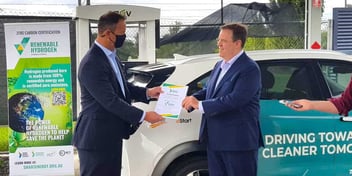Hydrogen, data and more: the energy transition between now and 2030

As the water sector pushes forward toward reducing carbon emissions, the pace of change in Australia’s energy landscape is greater than ever before. What will the green energy transition look like 10 years from now?
A recent KPMG report, 30 Voices on 2030: The future of energy, features 30 energy executives, experts and disruptors discussing what the state of the Australian energy landscape might be in 2030 and the different energy transition pathways likely to play a leading role.
Some of the key predictions offered in the report suggest that, by 2030, renewables will be the predominant source of energy in Australia, with both green hydrogen — produced using renewable energy or electrolysis from water — and blue hydrogen expected to dominate the remaining decarbonisation journey.
Furthermore, it’s expected that environment and social governance, or ESG, will be firmly embedded into core business strategies, and that the use of data and artificial intelligence will be driving clear efficiencies, with technology focused on emissions reductions and customer satisfaction.
The future energy mix
The Australian Industry Group CEO Innes Willox said that it has always been a challenge for industry and policy makers to move together on any issue, but that, by 2030, “the worst of the climate wars” will hopefully be behind us.
“Major political parties [will be] on board and, while there are elements that could go faster or things that could be done differently politically, the conversation [will be] fundamentally different to what it was. [There’ll be] much better collaboration on the overall goals of the new energy system,” he said.
Federal Minister for Energy and Emissions Reduction Angus Taylor said he believes that within 10 years, Australia’s energy and natural resources sectors will have evolved and reduced emissions faster than anyone expected.
“The extraordinary uptake of renewables, particularly household solar, towards the end of the 2010s, has been matched by huge growth into 2020s of a range of new low emissions energy technologies,” Taylor wrote.
“Energy sources, like hydrogen, [will become] more competitive with existing technologies — driving down emissions and producing affordable, reliable energy … As a platform technology, hydrogen’s impact [will be] widespread across multiple industries and sectors of the economy.”
CSIRO Hydrogen Industry Mission Leader Patrick Hartley agrees, saying hydrogen is set to become the game changer for Australia’s decarbonisation journey.
“People ask, what’s different for hydrogen this time around? I say, the abundant supply of very cheap renewable energy. In 2030, we [will be] getting close to $2/kg of hydrogen mark — even for green hydrogen — due to the ongoing reductions in renewable energy costs, and it will become cheaper still,” he wrote.
“Hydrogen technologies [will become] more mature. While work needs to be done in economies of scale, we are getting there. Where will the innovations come from for hydrogen next? It could be from a new use case.
“What is also positive is that more countries have hydrogen as a key part of their national energy strategies so that’s become quite a stimulus.”
Digital drivers
UNSW Energy Institute CEO Justine Jarvinen said the exponential amounts of data currently being created by smart metering and other monitoring devices will only increase, and that by 2030, smart devices will be “producing a tsunami of data”.
“[By 2030 we will have] realised increasingly that we were flying blind. As we know with data, it’s not quantity but the quality that is important ... it will take time for companies to extract the insights from the data,” she wrote.
“The volume of data in this new energy landscape [will result] in other considerations. The first is that consumers [will need] to make sure they are in control of their own data, which presents new business models for companies to provide new data related services to consumers.
“The second is that data — for optimising consumption, for exporting energy to the grid, for billing — needs to be granular, real-time and not behind proprietary walls.”
This trend towards customer-centric data leveraging has been identified by Energy Consumers Australia CEO Lynne Gallagher, too, who said the energy system of 2030 will be “transformed by consumers from the bottom-up”.
“The companies that [set to win] the decade in this new environment understand Australian household and small business consumers in all their diversity and [will shape] services accordingly,” she wrote.
“Consumers [will be] seen as ‘partners of change’ because the whole weight of the market and the place where value is created has shifted ‘behind the meter’ into the home and small business premises.”
Cicada Innovations CEO Sally-Ann Williams said the transition to ESG related business drivers will be about much more than executives “putting their money where their mouth is” when it comes to consumer expectations, it will be about the company’s long-term survival.
“We shouldn’t shy away from difficult tasks; we need to continue to lean into them because new technologies can provide greener energy solutions and prosperity for people and for the planet,” she wrote.
“It’s not an ‘either or’, it’s more of a ‘yes and’ opportunity. Take artificial intelligence and machine learning — that’s a whole lot of jobs and skills opportunities right there. The impact of having policies that are visionary and transformative, that meet sustainability goals and deliver reliable energy, can flow through to those jobs and opportunities.”
Want to know more about how industry leaders think 2030 will work? Take a look at the KPMG report here.


